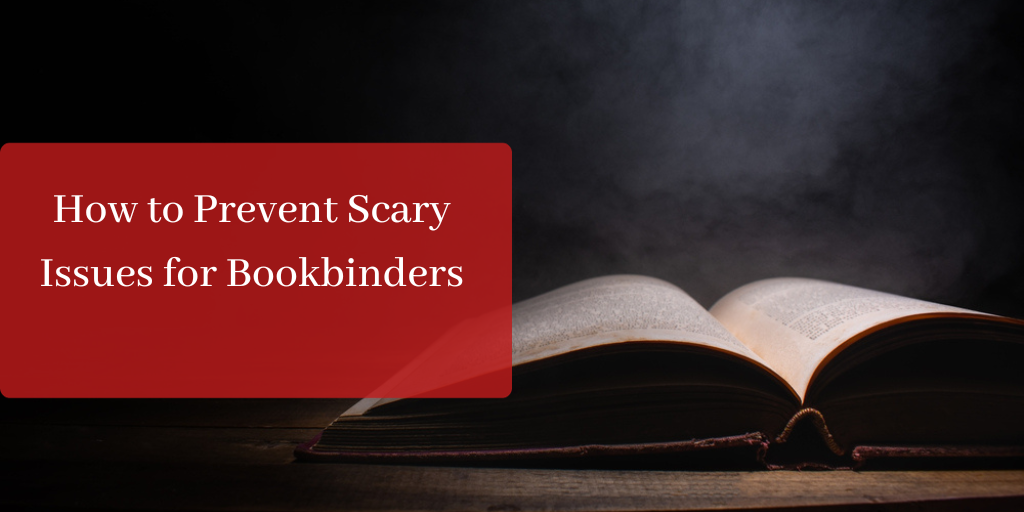Halloween is approaching, so that means it’s time to delve into the spookier side of bookbinding. Okay, granted, the world of adhesive may not exactly be the stuff of horror novels, but there are a few glue-related issues that can haunt bookbinders if left unchecked.
In this article, we’ll explore five spine-chilling problems bookbinders often encounter and provide you with solutions to keep the adhesive nightmares at bay.
1. Board Warp
Few things can be as challenging for bookbinders as board warp. You and your team can spend hours meticulously applying book covers, only to discover that they warp and buckle once applied like a haunted house on a stormy night.
The reason behind board warp isn’t paranormal; it’s moisture! Often, the adhesive application process is the real culprit. To prevent board warp, bookbinders should:
- Store unused board in a temperature-control environment with low humidity
- Apply only a thin layer of adhesive evenly and let it dry thoroughly
- Use a bone folder to smooth out any wrinkles while drying
- Check your gain alignment and make sure it’s parallel to the book spine.
2. Turns in on Cases Not Adhering
Picture this: you’ve expertly cut and folded your endpapers, but they refused to stay glued to the book’s case, and the turn-ins keep popping back out. It’s like a bookish poltergeist keeps pulling out the corners whenever you turn around!
The solution? Make sure you apply adhesive to both the bookcase and the turn-ins. If it’s still not sticking, you need to reevaluate your glue. It might not be the right formulation for your needs.
3. Poor Storage Conditions
Inventory spaces and warehouses can be a little unnerving. Unlike people, adhesives don’t fear dark places, but they do fear extreme temperature and humidity changes. Storing your gelatin glue in a cramped, poorly ventilated crypt-like environment can lead to unexpected problems.
The best way to store gelatin glue for bookbinding is in a cool, dry area. You should keep the glue cartons sealed in the plastic wrap they arrive in until they are ready for use. When you need to use the gelatin glue in storage, remove it ahead of time to allow it to become room temperature—it’s alive! This way, the protein glue melts faster and more efficiently into the glue pot without creating drastic temperature and consistency changes.
4. Using Too Much Adhesive
Using more glue doesn't always equal a better, sticker result. Often, it just makes a mess and can turn your work into a mummified artifact rather than a usable book. If you use too much adhesive during the bookbinding process, it can seep into the pages, making them stick together. Gross, right?
We can’t stress this enough—use a LIGHT TOUCH when applying glue. The best method to ensure you’re applying the right amount of adhesive is to use a Mil Depth gauge. Just like how paranormal investigators have a whole host of tools to help, a Mil Depth gauge can allow you to see just how glue you're applying.
5. Tricky Environmental Factors
Sometimes, battling against nature can be the scariest force of all. We touched on temperature above, but the bane of bookbinders everywhere often comes down to humidity, temperature, and air quality. All of these factors can affect the paper, board, and adhesive.
Overcoming the environment is a year-round concern as it often fluctuates depending on the season. Keep track of the climate within your production line, and adjust your adhesive application accordingly. Working in a cool, ventilated space with low humidity is ideal to prevent the environment from playing tricks on you.
Don’t Be Afraid! Help Is On the Way
This Halloween season, don't let adhesive-related issues haunt your bookbinding projects. With these tips, you can ensure that your bookbinding work remains a delightful treat, free from tricks.
So, arm yourself with the right knowledge and adhesive tools, and remember, bookbinding doesn't have to be scary when you know how to keep these issues at bay. If you are still facing adhesive challenges, you don’t have to go down that road alone. Let us know!







